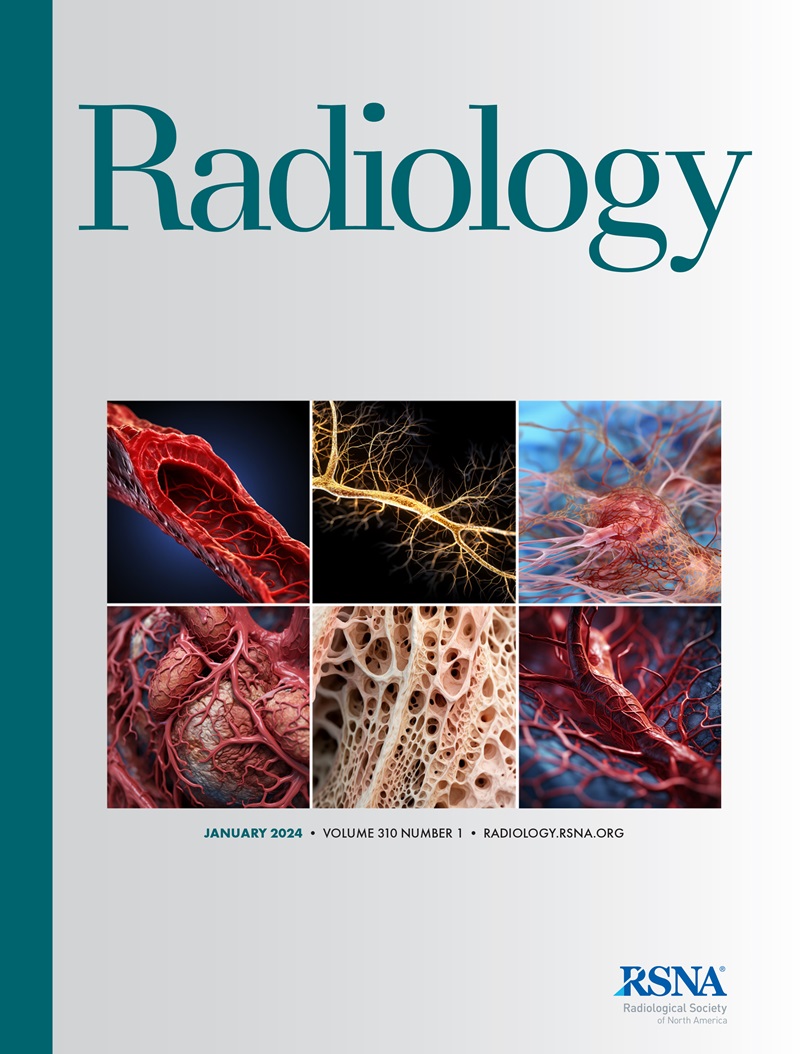Identifying Distinct Spatiotemporal Patterns of Juxtacortical Microstructure in Alzheimer Disease Using Diffusion MRI-derived Free Water Fraction.
IF 15.2
1区 医学
Q1 RADIOLOGY, NUCLEAR MEDICINE & MEDICAL IMAGING
引用次数: 0
Abstract
Background The free water fraction (FWF) is a potential imaging marker in Alzheimer disease (AD). Purpose To evaluate juxtacortical FWF, its association with neuropathologic severity, and its spatiotemporal pattern using MRI and PET in participants with AD or normal cognition. Materials and Methods This secondary analysis of a prospective study was conducted from November 2021 to July 2024, including diffusion MRI to assess FWF, fluorine 18 (18F) florbetapir PET to assess amyloid-β (Aβ), and 18F-MK-6240 PET to assess tau accumulation. Two independent subtype and stage inference (SuStaIn) models analyzed only juxtacortical FWF change or integrated FWF and Aβ. Results A total of 359 participants (mean age, 69 years ± 8 [SD]; age range, 40-86 years; 223 female) were included (161 with normal cognition, 85 with mild cognitive impairment due to AD, and 113 with dementia due to AD). Compared with controls, participants with AD had increased FWF (false discovery rate [FDR]-corrected P < .001 to P = .049), which was associated with higher global cortical Aβ and tau deposition (P < .001 to P = .04 for Aβ; P < .001 to P = .01 for tau; all FDR-corrected). The first SuStaIn model identified two distinct spatiotemporal trajectories of FWF: The orbitofrontal-first subtype had smaller left and right hippocampus volumes (left, b = -0.1 and P = .007; right, b = -0.08 and P = .03) and worse cognitive performance (verbal fluency test, b = -0.21 and P = .01; shape-trail test part A, b = 0.16 and P < .001) compared with the precuneus-first subtype. The second SuStaIn model integrating FWF and Aβ identified two subtypes: The amyloid-first subtype had higher levels of amyloid deposition in the cortex (b = -0.3 and P < .001), whereas the FWF-first subtype had lower left cortical thickness (b = -0.05 and P = .01) and worse cognitive performance (verbal fluency test, b = -0.17 and P = .02; shape-trail test part A, b = 0.20 and P < .001). Conclusion Juxtacortical FWF was higher in participants with AD compared with cognitively normal controls and associated with Aβ, tau, and neurodegeneration biomarkers. Distinct spatiotemporal progression patterns of FWF had distinct cognitive performance profiles. Clinical trial registration no. NCT05623124 © RSNA, 2025 Supplemental material is available for this article. See also the editorial by Schoonheim in this issue.利用弥散核磁共振提取的游离水组分识别阿尔茨海默病皮层旁微观结构的不同时空模式
游离水分数(FWF)是一种潜在的阿尔茨海默病(AD)影像学标志物。目的应用MRI和PET评价AD患者和认知正常患者皮质旁FWF与神经病理严重程度的关系及其时空模式。材料和方法本前瞻性研究的二次分析于2021年11月至2024年7月进行,包括弥散MRI评估FWF,氟18 (18F) florbetapir PET评估淀粉样蛋白-β (a β), 18F- mk -6240 PET评估tau积聚。两个独立的亚型和阶段推断(SuStaIn)模型仅分析近皮质FWF变化或综合FWF和Aβ。结果共纳入359例受试者(平均年龄69岁±8 [SD];年龄40-86岁;223例女性),其中认知正常161例,AD轻度认知障碍85例,AD痴呆113例。与对照组相比,AD患者的FWF增加(错误发现率[FDR]校正P < 0.001至P = 0.049),这与更高的整体皮质Aβ和tau沉积有关(Aβ P < 0.001至P = 0.04; tau P < 0.001至P = 0.01;所有FDR校正)。第一个SuStaIn模型确定了两种不同的FWF时空轨迹:眶额优先亚型的左右海马体积较小(左侧,b = -0.1, P = .007;右侧,b = -0.08, P = .03),认知表现较差(言语流畅性测试,b = -0.21, P = .01;形状轨迹测试A部分,b = 0.16, P < .001)。第二种整合FWF和Aβ的SuStaIn模型鉴定出两种亚型:淀粉样蛋白第一亚型的皮层淀粉样蛋白沉积水平较高(b = -0.3, P < .001),而FWF-第一亚型的左皮层厚度较低(b = -0.05, P = .01),认知能力较差(语言流畅性测试,b = -0.17, P = .02;形状痕迹测试部分,b = 0.20, P < .001)。结论AD患者的皮质旁FWF高于认知正常的对照组,并与Aβ、tau和神经变性生物标志物相关。不同的时空递进模式具有不同的认知表现特征。临床试验注册号:NCT05623124©RSNA, 2025本文提供补充材料。参见Schoonheim在本期的社论。
本文章由计算机程序翻译,如有差异,请以英文原文为准。
求助全文
约1分钟内获得全文
求助全文
来源期刊

Radiology
医学-核医学
CiteScore
35.20
自引率
3.00%
发文量
596
审稿时长
3.6 months
期刊介绍:
Published regularly since 1923 by the Radiological Society of North America (RSNA), Radiology has long been recognized as the authoritative reference for the most current, clinically relevant and highest quality research in the field of radiology. Each month the journal publishes approximately 240 pages of peer-reviewed original research, authoritative reviews, well-balanced commentary on significant articles, and expert opinion on new techniques and technologies.
Radiology publishes cutting edge and impactful imaging research articles in radiology and medical imaging in order to help improve human health.
 求助内容:
求助内容: 应助结果提醒方式:
应助结果提醒方式:


